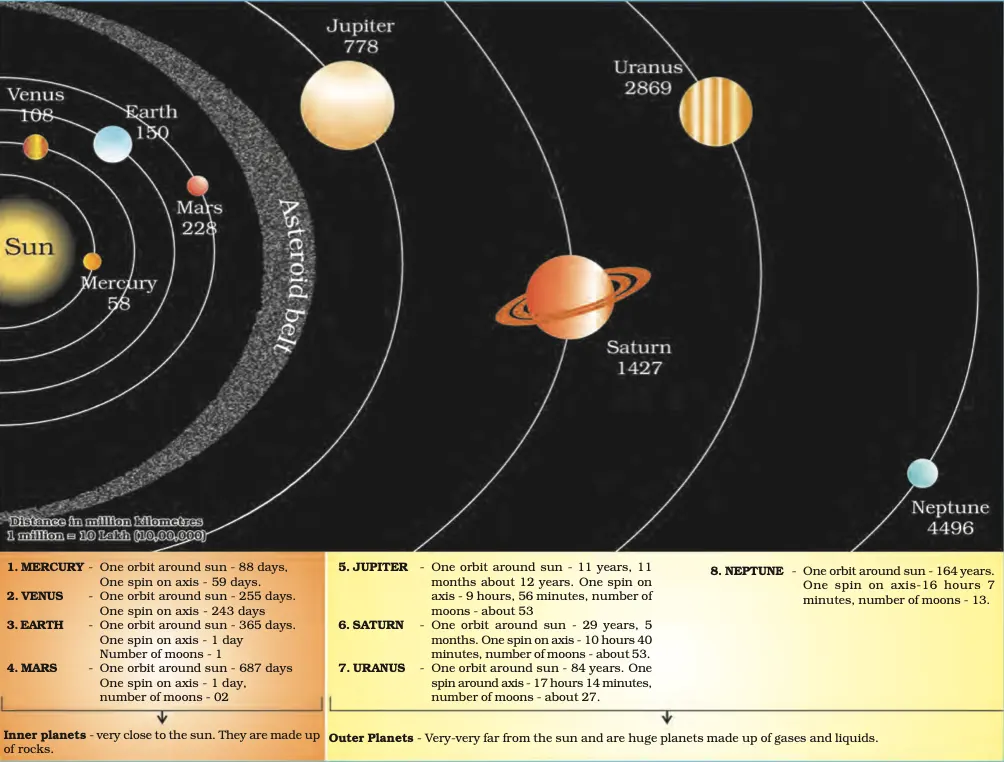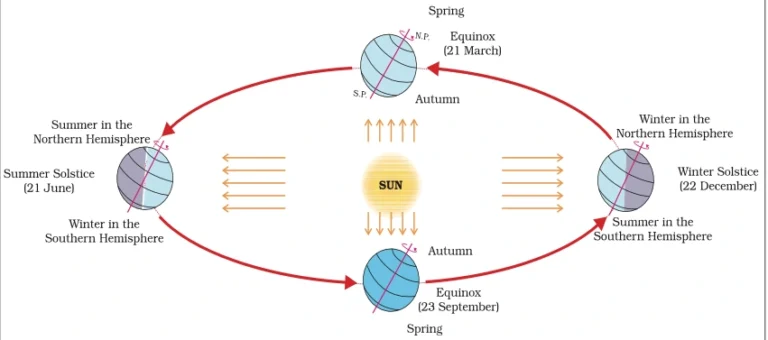Class 6 Geography Chapter 1 Notes- The Earth In The Solar System Notes Pdf Free
In this post, we provide NCERT Class 6 Geography Chapter 1 Notes:- The earth in the solar system. Notes of class 6 geography chapter 1 are based on the CBSE NCERT Book. You can also download class 6 geography chapter 1 notes pdf. The earth in the solar system notes provides you with a basic understanding of our solar system.
Table of Contents
The Earth in the Solar System Class 6 Notes
At night, the sky looks wonderful. You can see many tiny shining objects, some are bright and others are dim. Along with the bright object, you may see the moon most of the day.
- The shape and the time are different on different days.
- full moon- you can see a full moon in complete round shape once a month. This is called full moon night or Purnima.
- New Moon- After 15 days of the full moon, you can not see it. It is a new moon or Amavasya.
- Because sunlight is very bright. You cannot see all these objects in a day time.
Solar system:-
The sun, nine planets, satellites, and other celestial bodies like asteroids and meteoroids form the solar system.

Celestial bodies:-
All those objects shining in the night sky are called celestial bodies. Like the sun, moon, and stars.
Stars:-
characteristic of stars:-
- Big and hot Celestial body.
- Made up of gases.
- They have their own heat and light.
- The sun is also a star.
- They look so tiny because they are very far from us.
Constellation:-
In the night sky, you may notice various patterns formed by different groups of stars. These patterns are called constellation
Eg -Usha major or big bear
-Saptarshi ( Sapta- Seven Rishi- Saga) or small bear
-it is a group of seven stars.
Pole star-
- The north stars are called pole stars.
- It indicates the north direction.
- it always remains in the same position in the sky.
- you can locate it with the help of Saptarishi.
Planets:-
These are the celestial bodies that do not have their own heat. They are Lit by the light of the stars.
- The word planet comes from the Greek word “planets” which means “wanderer”.
- Earth is a planet
- it gets all the heat and light from the Sun.
The solar system:-
The sun, nine planets, satellites, and other celestial bodies like the asteroid and Metroid form the solar system.
The sun:-
- The sun is the centre of the solar system
- It is made up of extremely hot gases at the first stop so it is the ultimate source of light and energy.
- It has a pulling force that binds the solar system.
- it is about 150 million km from the Earth
Planets:-
Planets are celestial bodies that revolve around the sun and they do not have their own heat and light
There are eight planets in our solar system in order to distance from the Sun.
Mercury, Venus, Earth, Mars, Jupiter, Uranus, Neptune.
To memorize the names of the eight planets in the order of their distance from the sun.
Trick:- MY VERY EFFICIENT MOTHER JUST SERVED US NUTS
- Pluto was also considered a planet till August 2006 after that Pluto was called a Dwarf planet.
- All eight planets revolve around the sun in a fixed path called Orbit. These paths are elongated.
some facts about planets:-
The earth:-
Earth is the fifth-largest And third nearest planet to the sun. The shape of the earth is described as Geoid (Earth-like shape) because it is slightly flattened at the pole
- Earth has all Essentials like water air suitable temperature so that life is possible on earth this makes Earth a unique planet
- The earth appears blue when someone sees it from outer space because two-thirds are covered by water. that’s why it is called the blue planet.\
The moon:-
The earth has only one satellite, the moon.
- Its diameter is one-fourth that of the earth.
- its distance from Earth is about 384400 km
- it moves around the earth in about 27 days
- it takes the exactly the same time to complete one spin so that we see only one side of the Moon
- It has mountains, Plains and depressions on its surface. we can observe their shadow on the full moon.
- There is no life on the moon.
- Neil Armstrong was the first man to step on the surface of the moon on 21 July 1969.
Asteroids:-
These are the tiny bodies that also move around the sun. These bodies are called asteroids.
- They are found between the orbits of Mars and Jupiter.
- Ceres is the largest asteroid.
Meteoroids:-
The small pieces of rocks which move around the sun are called meteoroids.
These meteoroids come near to the Earth due to friction with the air they get heated up and Burn. It causes a flash of light. Sometimes a meteor falls on the earth without being completely burnt; it creates a hollow on the earth’s surface.
Galaxy:-
It is a system of billions of stars and clouds of dust and gases.
- There are millions of such galaxies that make up the universe.
- Our solar system is a part of the Milky Way galaxy. It is also called Dugdh Mekhla.
- its shape is सर्पिलाकार.
We class 6th geography chapter 1 notes help in your study. You can make a class 6 geography chapter 1 summary in your own words.
Question Based On The Earth in the Solar System Class 6 Notes
-
Name the eight planets in order from the Sun.
Names of eights planets in order from the Sun are: Mercury, Venus, Earth, Mars, Jupiter, Saturn, Uranus, Neptune.
-
Why is Earth called the blue planet?
The Earth called the blue planet Because two-thirds of its surface is covered by water.
-
What is the sun made of and what role does it play in the solar system?
The sun is made of extremely hot gases and is the ultimate source of light and energy, binding the solar system with its gravitational pull.
-
Do planets have their own heat and light?
No, planets don’t have their own heat and light they are lit by the light of stars.
-
What are asteroids and where are they commonly found?
Asteroids are tiny bodies that move around the sun, commonly found between the orbits of Mars and Jupiter.
-
What is a galaxy and which galaxy is our solar system part of?
A galaxy is a system of billions of stars and clouds of dust and gases. Our solar system is part of the Milky Way galaxy.
Class 6 Geography all Chapter solution:-
| Solution |
|---|
| Class 6 Geography Chapter 1 Solution:- The Earth In the Solar System |
| Class 6 Geography Chapter 2 Solution:- Globe: Latitudes and Longitudes |
| Class 6 Geography Chapter 3 Solution:- Motion of the Earth |
| Class 6 Geography Chapter 4 Solution:- Maps |
| Class 6 Geography Chapter 5 Solution:- Major Domains of the Earth |
| Class 6 Geography Chapter 6 Solution:- Major Landforms of the earth |
| Class 6 Geography Chapter 7 Solution:- Our Country – India |
| Class 6 Geography Chapter 8 Solution:- India: Climate, Vegetation, and Wildlife |
